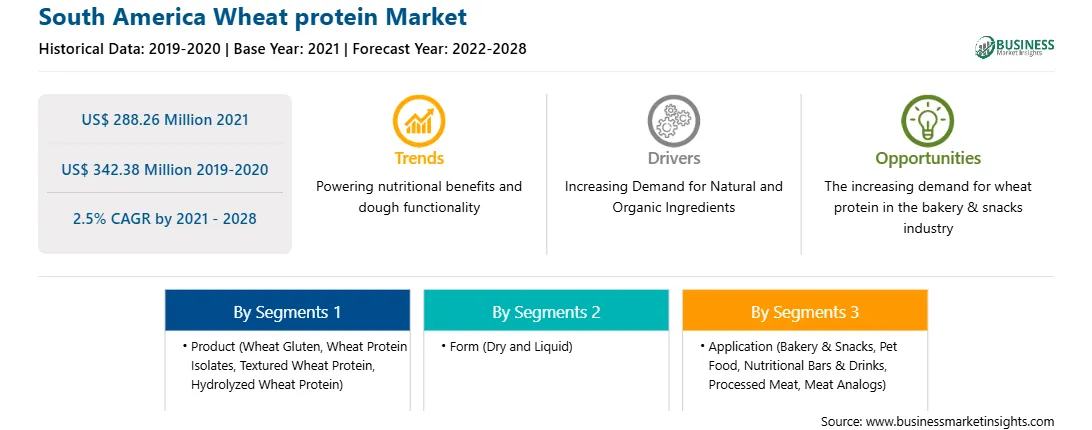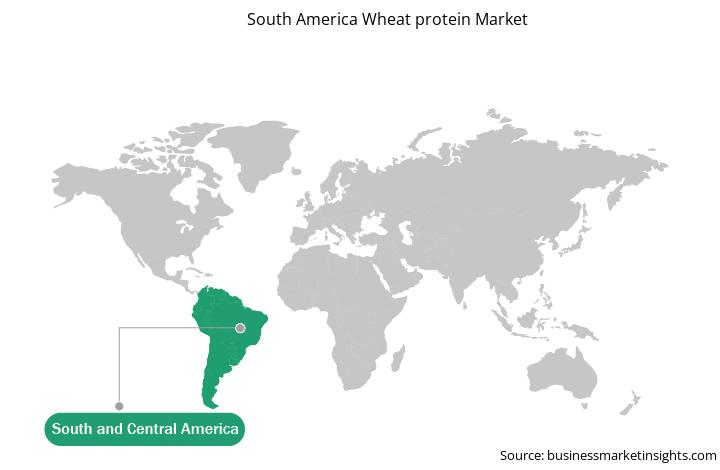南美洲小麦蛋白市场预测至 2028 年 - COVID-19 影响和按产品(小麦麸质、小麦分离蛋白、组织化小麦蛋白和水解小麦蛋白)、形式(干和液体)和应用(面包和零食、宠物食品、营养棒和饮料、加工肉、人造肉等)
No. of Pages: 100 | Report Code: TIPRE00027192 | Category: Food and Beverages
No. of Pages: 100 | Report Code: TIPRE00027192 | Category: Food and Beverages
人造肉是为了模仿而生产的食品肉制品的风味、外观和质地。人造肉正在引起各种消费者的兴趣,他们寻求美味、健康、对环境影响低、具有成本效益、合乎道德的新型食品。近年来,由于健康问题、个人信仰和社会原因等多种原因,人造肉的消费量不断增长。有纹理的植物蛋白(主要是大豆、小麦及其组合)用于改善口感并模拟肉类类似物中的“原始肉质地”,这是由于它们在烹饪过程中水合时产生的质地。组织化小麦蛋白具有类似肉类的质地,因此可用于部分或完全替代肉类。组织化小麦蛋白具有优异的中性味道和稳定的水合质地,使其适合各种应用,尤其是人造肉。此外,组织化小麦蛋白在人造肉配方中发挥着重要作用,因为它们提供多种形状、大小和颜色,易于配方,并且具有营养价值(高蛋白且不含胆固醇)。因此,纯素食人口的增长,加上对肉类替代品的需求不断增加,预计将成为预测期内为小麦蛋白市场创造利润丰厚的增长机会的关键因素。
巴西报告的 COVID-19 病例数量最多,其次是阿根廷、秘鲁、智利和厄瓜多尔等。 SAM 政府已采取一系列行动,通过封锁、贸易禁令和旅行限制来保护其公民并抗击 COVID-19 病毒的传播。由于从供应商采购原材料的严重中断以及由于无限期封锁和临时隔离而暂时关闭的制造基地,这可能会对小麦蛋白市场的增长产生直接影响。随着封锁的放松,对健康烘焙食品和植物蛋白的需求增加,这增加了对小麦蛋白市场的需求。与此同时,巴西等国家对肉类替代品的需求增加正在推动 SAM 的小麦蛋白市场。
借助新功能和技术,供应商可以吸引新客户并扩大其在新兴市场的足迹。这一因素可能会推动 SAM 小麦蛋白市场的发展。 SAM 小麦蛋白市场预计在预测期内将以良好的复合年增长率增长。
< h3>·
·
Strategic insights for South America Wheat protein involve closely monitoring industry trends, consumer behaviours, and competitor actions to identify opportunities for growth. By leveraging data analytics, businesses can anticipate market shifts and make informed decisions that align with evolving customer needs. Understanding these dynamics helps companies adjust their strategies proactively, enhance customer engagement, and strengthen their competitive edge. Building strong relationships with stakeholders and staying agile in response to changes ensures long-term success in any market.

| Report Attribute | Details |
|---|---|
| Market size in 2021 | US$ 288.26 Million |
| Market Size by 2028 | US$ 342.38 Million |
| Global CAGR (2021 - 2028) | 2.5% |
| Historical Data | 2019-2020 |
| Forecast period | 2022-2028 |
| Segments Covered |
By 产品
|
| Regions and Countries Covered | 南美洲和中美洲
|
| Market leaders and key company profiles |
The regional scope of South America Wheat protein refers to the geographical area in which a business operates and competes. Understanding regional nuances, such as local consumer preferences, economic conditions, and regulatory environments, is crucial for tailoring strategies to specific markets. Businesses can expand their reach by identifying underserved regions or adapting their offerings to meet regional demands. A clear regional focus allows for more effective resource allocation, targeted marketing, and better positioning against local competitors, ultimately driving growth in those specific areas.

The South America Wheat protein Market is valued at US$ 288.26 Million in 2021, it is projected to reach US$ 342.38 Million by 2028.
As per our report South America Wheat protein Market, the market size is valued at US$ 288.26 Million in 2021, projecting it to reach US$ 342.38 Million by 2028. This translates to a CAGR of approximately 2.5% during the forecast period.
The South America Wheat protein Market report typically cover these key segments-
The historic period, base year, and forecast period can vary slightly depending on the specific market research report. However, for the South America Wheat protein Market report:
The South America Wheat protein Market is populated by several key players, each contributing to its growth and innovation. Some of the major players include:
The South America Wheat protein Market report is valuable for diverse stakeholders, including:
Essentially, anyone involved in or considering involvement in the South America Wheat protein Market value chain can benefit from the information contained in a comprehensive market report.